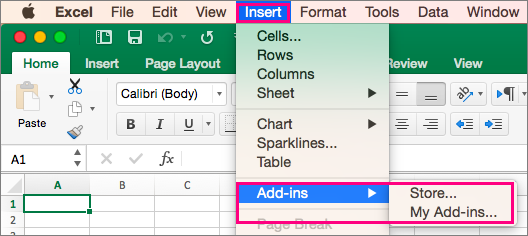
Microsoft Excel is a spreadsheet developed by Microsoft for Windows, macOS, Android and iOS.It features calculation, graphing tools, pivot tables, and a macro programming language called Visual Basic for Applications.It has been a very widely applied spreadsheet for these platforms, especially since version 5 in 1993, and it has replaced Lotus 1-2-3 as the industry standard for spreadsheets. Microsoft never supplied an Analysis ToolPak for Excel 2011. Instead they partnered with AnalystSoft to provide StatPlus mac LE.The instructions provided in Mac Help are supplied below, but now that Office 2011 is deprecated I don't know whether the offer still is valid.
In regression analysis, the LOGEST function calculates an exponential curve that fits your data and returns an array of values that describes the curve. Because this function returns an array of values, it must be entered as an array formula.
Note: If you have a current version of Office 365, then you can simply enter the formula in the top-left-cell of the output range, then press ENTER to confirm the formula as a dynamic array formula. Otherwise, the formula must be entered as a legacy array formula by first selecting the output range, entering the formula in the top-left-cell of the output range, and then pressing CTRL+SHIFT+ENTER to confirm it. Excel inserts curly brackets at the beginning and end of the formula for you. For more information on array formulas, see Guidelines and examples of array formulas.
Description
The equation for the curve is:

y = b*m^x
or
y = (b*(m1^x1)*(m2^x2)*_)
Microsoft Excel For Data Analysis
if there are multiple x-values, where the dependent y-value is a function of the independent x-values. The m-values are bases corresponding to each exponent x-value, and b is a constant value. Note that y, x, and m can be vectors. The array that LOGEST returns is {mn,mn-1,...,m1,b}.
Syntax
LOGEST(known_y's, [known_x's], [const], [stats])
The LOGEST function syntax has the following arguments:
known_y's Required. The set of y-values you already know in the relationship y = b*m^x.
If the array known_y's is in a single column, then each column of known_x's is interpreted as a separate variable.
If the array known_y's is in a single row, then each row of known_x's is interpreted as a separate variable.
known_x's Optional. An optional set of x-values that you may already know in the relationship y = b*m^x.
The array known_x's can include one or more sets of variables. If only one variable is used, known_y's and known_x's can be ranges of any shape, as long as they have equal dimensions. If more than one variable is used, known_y's must be a range of cells with a height of one row or a width of one column (which is also known as a vector).
If known_x's is omitted, it is assumed to be the array {1,2,3,...} that is the same size as known_y's.
const Optional. A logical value specifying whether to force the constant b to equal 1.
If const is TRUE or omitted, b is calculated normally.
If const is FALSE, b is set equal to 1, and the m-values are fitted to y = m^x.
stats Optional. A logical value specifying whether to return additional regression statistics.
If stats is TRUE, LOGEST returns the additional regression statistics, so the returned array is {mn,mn-1,...,m1,b;sen,sen-1,...,se1,seb;r 2,sey; F,df;ssreg,ssresid}.
If stats is FALSE or omitted, LOGEST returns only the m-coefficients and the constant b.
For more information about additional regression statistics, see the LINEST function.
Mac Data Recovery
Remarks
The more a plot of your data resembles an exponential curve, the better the calculated line will fit your data. Like LINEST, LOGEST returns an array of values that describes a relationship among the values, but LINEST fits a straight line to your data; LOGEST fits an exponential curve. For more information, see LINEST.
When you have only one independent x-variable, you can obtain y-intercept (b) values directly by using the following formula:
Y-intercept (b):
INDEX(LOGEST(known_y's,known_x's),2)You can use the y = b*m^x equation to predict future values of y, but Microsoft Excel provides the GROWTH function to do this for you. For more information, see GROWTH function.
When entering an array constant such as known_x's as an argument, use commas to separate values in the same row and semicolons to separate rows. Separator characters may be different depending on your regional settings.
You should note that the y-values predicted by the regression equation may not be valid if they are outside the range of y-values you used to determine the equation.
Example
Microsoft Excel 2011 Mac Data Analysis Download
You must enter the above formula as an array formula in Excel for it to work correctly. After you enter the formula, press Enter if you have a current Office 365 subscription; otherwise press Ctrl+Shift+Enter. If the formula is not entered as an array formula, the single result is 1.4633.
Need more help?
Microsoft Excel Data Analysis Tutorial
Microsoft Excel 2011 Mac Data Analysis Free
You can always ask an expert in the Excel Tech Community, get support in the Answers community, or suggest a new feature or improvement on Excel User Voice.

Microsoft Excel has a built-in suite of tools that perform regressionanalysis and calculate statistical data. These tools are generallyinstalled but are not active. To activate them, follow theappropriate instructions below.
Excel 2010 and 2007 for Windows
- From the File tab (2010) or Office Buttonmenu (2007), select Options or Excel Options.
- Click Add-ins, and then in the 'Manage' box, selectExcel Add-ins. Click Go.
- In the 'Add-Ins available' box, check Analysis ToolPakand Analysis ToolPak - VBA, and then click OK.
- If you see a prompt stating that the Analysis Toolpak is notcurrently installed on your computer, click Yes to installit. This will create a 'Data Analysis' section within theData tab.
Microsoft Excel 2011 Mac Data Analysis Pdf
Excel 2011 for Mac
To activate statistical analysis tools, click Tools,and then Add-ins. In the dialog box that pops up, chooseSolver.Xlam.
To access the tools, click Tools and then Solver.
Microsoft Excel For Mac 2011
Excel 2008 for Mac
This functionality was removed in Office 2008. Some third partyadd-ins (such as those linked below) attempt to provide similarfunctionality; however, they may not be free.